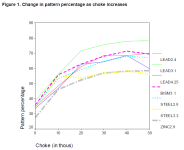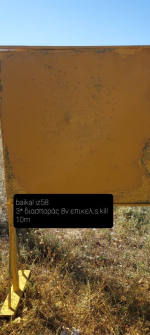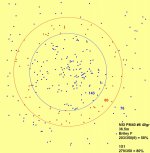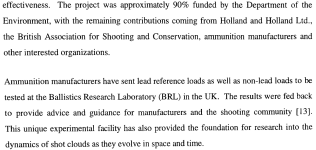gvp9000
Banned
Έτσι είναι ...Άρα:
από κυλ σε 1/4 τσοκ 15% διαφορά
από 1/4 τσοκ σε μισό 6% διαφορά
από μισό σε 3/4 τσοκ 6% διαφορά
από 3/4 σε φουλ τσοκ 4% διαφορά
Σχετικό ... το συνημμένο.
Αν το διαβάσετε ΟΛΟ θα δείτε γιατί υπάρχουν οι παρανοήσεις ...
Δώστε σημασία σε αυτό
================
The most recent information on the subject comes from Roger Giblin and David Compton of
University College London’s former Ballistic Research Laboratory and was obtained during their
pioneering work on the ballistic performance of different types of cartridge
All firings used a standard test barrel with the same widely-used linear tapered chokes at 40yd and cartridges from
the same batch for each test. Ten cartridges were fired from each choke from cylinder (0
thousandths of an inch constriction) to full choke (nominally 40 thous ) plus “super full” (50 thous),
because fewer firings were found not sufficiently reliable to characterise the pattern of a given
choke.
They used three different lead cartridges with pellet size running from 2.4mm (No.7) to 4.25mm
(BB+), one bismuth at 3.1mm (No.4), two steel at 2.8mm (No.5) and 3.3mm (No.3), and one zinc
at 2.9mm (approx No.5).
Figure 1 shows the general picture from all the test loads with the surprising result that, even with
the same cartridge, the pattern percentage does not increase consistently with choke.
There is a clear increase from cylinder (0 thous) to quarter choke (10 thous) and in most but not all loads
from quarter to half choke (20 thous) although sometimes this is only slight. After half choke the
increase is only slight at most. Pattern percentage then even decreases, especially from full (40
thous) to super full (50 thous). Clearly this is a real result as it occurs more or less consistently
with pellet sizes from No. 7 to BB and with different shot materials and makes of cartridge.

Πέρα από αυτά τα θεωρητικά το έχω δει να συμβαίνει στην πραγματικότητα και σε δικές μου δοκιμές.












